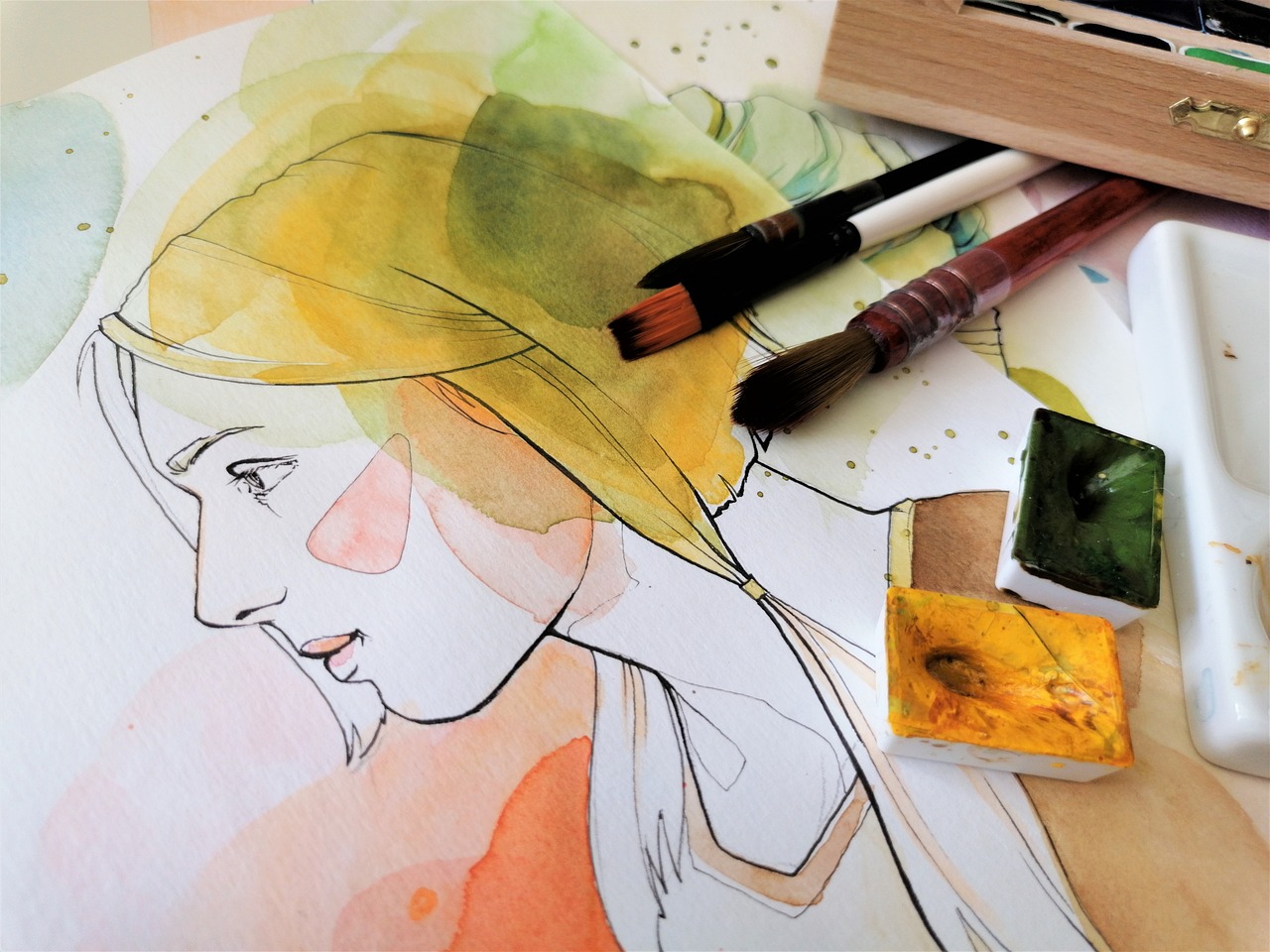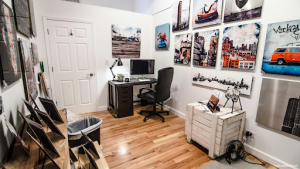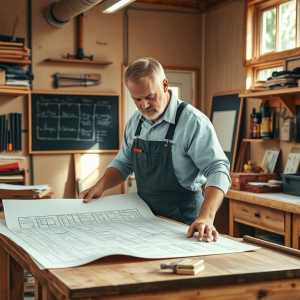Last Updated on June 24, 2025 by teamobn
Embarking on a home renovation or home building project is an exhilarating journey, a meticulous dance between vision and execution. You pore over blueprints, agonize over material choices, and meticulously plan every structural detail, all with the ultimate goal of creating the home of your dreams. Yet, amidst the dust and decisions, one crucial element often gets relegated to an afterthought: art.
While it might seem like a mere “finishing touch,” integrating art into your newly transformed space is not just about hanging pretty pictures; it’s about infusing soul, personality, and a profound sense of completion into your most significant investment. It’s the difference between a beautifully constructed house and a truly lived-in, inspiring home.
Home renovations are undeniably complex, often stretching over months as you navigate contractors, budgets, and countless design choices. The excitement of seeing walls go up and new spaces take shape is immense, but the true magic happens when these structures begin to reflect you.
This is where art steps in, transforming cold, new surfaces into warm, inviting environments. Decorating with art isn’t merely the final step; it’s a powerful act of personalization that elevates your renovation from a functional upgrade to an artistic triumph. It’s the element that breathes life into your freshly renovated pad, making it a joy to inhabit and a true reflection of your aspirations.
While interior decorating and styling are typically the last phases of any home project, their importance cannot be overstated. These seemingly final touches possess an extraordinary power to redefine the entire aesthetic, enhancing the design and imbuing your space with character. In fact, the process of selecting and integrating art can even inject a much-needed dose of fun and creativity into the often-stressful renovation process. It’s an opportunity to express yourself, to tell your story through curated pieces that resonate with your spirit and complement your newly designed environment.
In this comprehensive guide, we will delve deep into the profound importance of art pieces for a truly successful home renovation. We’ll explore how art goes beyond mere decoration, becoming an integral part of your home’s identity, enhancing its appeal, and contributing to your overall well-being. Prepare to discover how thoughtful art integration can elevate your renovated space from a mere structure to a personal masterpiece, ensuring every corner reflects your unique vision and brings you lasting joy.
Contents
- 1 Art Improves the Overall Atmosphere: Crafting Your Home’s Soul
- 2 Art Sparks Creativity and Imagination: A Sanctuary for the Mind
- 3 Art Lets You Add Character to Your Home: Your Story on Display
- 4 Art Helps You Have a Cohesive Look: Tying Your Design Together
- 5 Introduce Color and Texture: Bringing Your Walls to Life
- 6 Planning for Art During the Build: Integrating Beauty from the Blueprint
- 7 Choosing the Right Art for Your Renovated Space: A Practical Guide
- 8 Protecting Your Investment: Caring for Your Art
- 9 Art as an Evolving Element: Your Home’s Dynamic Narrative
Art Improves the Overall Atmosphere: Crafting Your Home’s Soul
After weeks or months of construction, dust, and decision-making, your newly renovated home stands ready. The fresh paint gleams, the new flooring shines, and the updated fixtures sparkle. Yet, sometimes, despite all the upgrades, a space can feel a little… sterile. This is precisely where art steps in, transforming a mere structure into a vibrant, living environment. Art has an unparalleled power to shift the aesthetic and profoundly influence the overall vibe of a room, making it feel truly complete and lived-in. It’s why art has become one of the most critical considerations for homeowners, especially as the ultimate finishing touch for a successful home renovation.
An artwork is far more than just a decorative item; it’s a powerful tool for injecting personality and cultivating an inviting atmosphere. Imagine walking into a beautifully renovated living room. Without art, it might feel pristine but impersonal. Add a captivating piece of art, and suddenly, the room gains a focal point, a conversation starter, and an immediate sense of character. The right artwork can evoke emotions, spark curiosity, and create a narrative within your space, making it feel warm, welcoming, and uniquely yours. When selecting art, it’s essential to consider the existing décor and the architectural style of your renovated home to ensure a harmonious and cohesive look. This thoughtful integration ensures that your art doesn’t just sit on the wall but actively contributes to the welcoming vibe that will make both you and your guests feel comfortable and inspired.
Consider the mood you wish to cultivate in each renovated space. Do you envision a dramatic, energetic ambiance in your new dining area? A large, vibrant abstract piece with bold colors could be the perfect statement. Its dynamic energy would complement lively gatherings and infuse the room with a sense of excitement. Conversely, if your goal is to create a serene, calming sanctuary in a newly designed bedroom or a quiet reading nook, smaller, more understated pieces in muted or earthy tones would be ideal. Think of tranquil landscapes, soft pastels, or minimalist compositions that promote relaxation and introspection. The beauty of art lies in its versatility; it allows you to fine-tune the emotional resonance of each room, ensuring that your renovated home not only looks stunning but also feels exactly as you intend.
The accessibility of art today means that finding the perfect piece is easier than ever. Online fine art stores, for instance, offer an astonishing variety of styles, mediums, and price points, allowing you to browse and discover pieces that genuinely resonate with your vision. This ease of access empowers you to be a curator of your own space, selecting artworks that not only match your décor but also speak to your soul, ensuring that every corner of your renovated home contributes to the desired atmosphere. It’s about creating a space that doesn’t just house your life but actively enhances it, providing a backdrop that is both beautiful and emotionally resonant.
Art Sparks Creativity and Imagination: A Sanctuary for the Mind
Beyond its aesthetic appeal, art serves a profound purpose in nurturing your mental well-being, transforming your renovated home into a sanctuary for thought and inspiration. A home renovation isn’t merely about acquiring a new place to sleep; it’s about crafting a space where you can truly unwind, shed the burdens of daily life, and recharge your spirit. This personal haven should not only offer peace of mind but also actively encourage you to explore your potential and be the best version of yourself. And indeed, art possesses a unique capacity to facilitate this.
Consider the subtle yet powerful influence of a captivating painting or a thought-provoking sculpture. Such pieces can act as catalysts for creativity and imagination, gently nudging your mind to seek innovative solutions and embrace new ideas. In a world that often demands rigid adherence to routine, having visual stimuli that encourage free association and imaginative thought can be incredibly liberating. Your home, adorned with art that speaks to you, becomes a fertile ground where ideas can flourish, where challenges can be reframed, and where personal growth is not just a concept but a daily experience. This environment empowers you to approach obstacles with renewed perspective, confident in your ability to navigate life’s complexities.
Art also offers a unique lens through which to view the world, fostering empathy and broadening your understanding. By engaging with diverse artistic expressions, you are exposed to different perspectives, cultures, and ways of seeing, which can enrich your own personal growth journey. The act of surrounding yourself with art is therefore not just a feast for the eyes; it’s a continuous invitation to introspection and expansion. It provides a quiet space for reflection, allowing you to process thoughts and emotions in a way that contributes significantly to your mental well-being. After the often-demanding process of renovation, creating a home that actively supports your cognitive and emotional health is an invaluable investment. Art, in this context, becomes a silent partner in your journey towards a more inspired and fulfilling life within your beautifully transformed space.
Art Lets You Add Character to Your Home: Your Story on Display
Your home is more than just a structure; it is your sanctuary, a reflection of your identity, and a canvas for your life’s story. After the significant undertaking of a home renovation, you want your space to resonate with who you are, to speak volumes about your personality, passions, and experiences. Fortunately, art offers the most direct and impactful way to inject this unique character and personalize your newly designed environment. It’s the element that transforms a generic, renovated space into a truly bespoke haven.
To achieve this, the key is to select art pieces that genuinely resonate with you, pieces that you connect with on an emotional or intellectual level. The beauty of the art world lies in its vast diversity, offering an almost endless array of options to suit every taste and preference. Whether your heart is drawn to the vibrant brushstrokes of a contemporary painting, the intricate details of a classical landscape, or the compelling forms of a modern sculpture, the choice is entirely yours. Each piece you select becomes a chapter in your home’s narrative, adding depth, intrigue, and a sense of curated intentionality that mass-produced decor simply cannot replicate.
One of the most liberating aspects of decorating with art is its inherent flexibility. Unlike fixed architectural elements or large furniture pieces, art can be easily changed, allowing your home’s aesthetic to evolve with your tastes, the seasons, or even your mood. If you find yourself growing tired of your current decor, a simple swap of artwork can completely revitalize a room, offering a fresh perspective without the need for another major renovation. This adaptability also allows for delightful seasonal transformations; imagine adorning your walls with warm, earthy tones and cozy scenes for autumn and winter, then transitioning to bright, airy pieces that evoke spring and summer. Art empowers you to continuously refresh and reimagine your living space, ensuring it always feels current, engaging, and reflective of your present self. This dynamic quality of art makes it an invaluable asset in a renovated home, allowing your space to grow and change with you, rather than remaining static.
Art Helps You Have a Cohesive Look: Tying Your Design Together
After investing significant time, effort, and resources into a home renovation, the last thing any homeowner wants is for their beautifully updated space to feel disjointed, messy, or unfinished. You’ve meticulously chosen every fixture, every tile, and every paint color, but sometimes, despite all the individual elements being perfect, the overall space lacks a sense of unity. This is precisely where art, as a crucial finishing touch, plays an indispensable role in preventing such scenarios, helping you achieve a truly cohesive and harmonious design.
Art has an extraordinary ability to act as a visual anchor, subtly connecting disparate elements within a room and guiding the eye through the space. If, after your renovation, you find yourself feeling that something is subtly missing, that the various components of your design aren’t quite gelling, then turning to art is often the perfect solution. A well-chosen piece can bridge the gaps between different furniture styles, color palettes, or textural elements, creating a seamless flow that makes the entire décor work together beautifully. It’s like the final piece of a puzzle, bringing clarity and completeness to your design vision.
For instance, an artwork can pick up on accent colors used in throw pillows, a rug, or even a piece of furniture, echoing those hues and distributing them visually throughout the room. This repetition of color, even in subtle ways, creates a sense of intentionality and cohesion. Similarly, the textures present in an artwork – whether the impasto of an oil painting, the smooth surface of a photograph, or the tactile quality of a textile art piece – can complement or contrast with the textures of your furnishings, adding depth and richness to the overall design. By carefully selecting art that resonates with your chosen aesthetic, you can reinforce your design narrative, ensuring that every element, from the largest sofa to the smallest decorative object, feels like it belongs. Art, in this capacity, becomes the silent conductor of your interior symphony, orchestrating a unified and inviting atmosphere that truly celebrates your renovation efforts.
Introduce Color and Texture: Bringing Your Walls to Life
In the realm of interior design, a common challenge after a renovation is preventing a newly updated room from appearing bland, monotonous, or even sterile. Often, a space can feel incomplete if it lacks a vibrant pop of color or intriguing textural elements. This is where art emerges as an unparalleled solution, capable of introducing both visual excitement and tactile richness, thereby transforming a merely functional space into a dynamic and engaging environment. Art has the unique ability to breathe life into your house, making it feel truly alive and reflective of your desired aesthetic.
Artworks are masterful at introducing color. They can serve as the primary source of an accent color in a room, drawing the eye and creating a focal point. Imagine a neutral-toned living room, perhaps with shades of grey, beige, or white dominating the walls and furniture. While elegant, such a space can sometimes feel understated. Introduce a large abstract painting bursting with vivid blues, fiery oranges, or lush greens, and suddenly the room is infused with energy and personality. This strategic use of color through art can instantly elevate the mood and visual interest of the entire space. Conversely, if your aim is to cultivate a calming, tranquil vibe, art pieces featuring softer, more muted palettes – gentle pastels, serene landscapes, or monochromatic studies – can reinforce that sense of peace and relaxation. The choice of art allows you to precisely control the emotional temperature of your renovated rooms.
Beyond color, art is also an exceptional vehicle for introducing texture. Texture, in design, refers to the perceived surface quality of a work of art. This can be actual (tactile) texture, like the raised brushstrokes of an oil painting or the woven fibers of a tapestry, or implied (visual) texture, where the artist creates the illusion of texture on a flat surface. Both types add depth and complexity to a room, preventing it from feeling flat or one-dimensional.
A highly textured piece of art can provide a fascinating contrast to smooth walls and sleek furniture, adding a layer of visual interest that invites closer inspection. For instance, a sculptural wall hanging or a mixed-media piece can introduce an unexpected tactile dimension, making the space feel richer and more layered. By thoughtfully integrating art that offers both compelling color and varied texture, you ensure that your renovated home is not just visually appealing but also rich in sensory experience, creating an environment that is both beautiful and deeply engaging.
Planning for Art During the Build: Integrating Beauty from the Blueprint
For home builders and renovators, the journey of creating a dream home often begins with structural plans, material selections, and functional layouts. However, to truly elevate a renovated space from merely functional to profoundly inspiring, the consideration of art should ideally begin much earlier than the final decorating phase. Integrating art into your design vision from the outset can significantly enhance the overall aesthetic and ensure that your chosen pieces feel organically part of the home, rather than mere additions.
Thinking about art during the planning phase involves several key considerations. Firstly, consider the wall space you are creating. Are there large, uninterrupted walls that could serve as a dramatic backdrop for a significant artwork? Or are there smaller nooks and crannies that would benefit from a more intimate piece? By envisioning where art might reside, you can make conscious decisions about electrical outlets for lighting, wall reinforcements for heavy pieces, or even the placement of windows and doors to optimize natural light for future art displays. This foresight prevents costly retrofits and ensures that your art has the perfect stage.
Secondly, consider lighting. Art, especially paintings and sculptures, benefits immensely from proper illumination. During renovation, you have the unique opportunity to install dedicated art lighting – whether it’s track lighting, picture lights, or recessed spotlights – that will beautifully highlight your collection without casting harsh shadows or causing glare. Planning for this early means wiring can be concealed within walls, leading to a much cleaner and more professional finish. Natural light is also crucial; understanding how sunlight enters a room throughout the day can help you position art to avoid direct, damaging rays while still benefiting from ambient brightness.
Finally, think about focal points. Every well-designed room needs a focal point, an area that immediately draws the eye. While a fireplace or a large window can serve this purpose, a powerful piece of art can be an equally compelling, if not more personal, focal point. By identifying these potential areas during the renovation planning, you can design the surrounding elements – such as built-in shelving, furniture arrangement, or even the texture of an adjacent wall – to complement and enhance the artwork that will eventually reside there. This proactive approach ensures that art is not just an afterthought but an integral component of your home’s architectural and interior design, creating a truly harmonious and impactful living environment.
Choosing the Right Art for Your Renovated Space: A Practical Guide
Once the structural work of your renovation is complete and you’ve laid the groundwork for art integration, the exciting task of selecting the perfect pieces begins. This isn’t just about personal taste; it’s also about understanding how art interacts with its environment. Here’s a practical guide to help you choose art that truly enhances your newly transformed home:
Scale and Proportion: Finding the Perfect Fit
One of the most common mistakes in art placement is choosing a piece that is either too small or too large for its intended space. In a newly renovated room, where walls might be expansive or ceilings soaring, getting the scale right is paramount. A piece that is too small can get lost on a large wall, appearing insignificant and failing to create the desired impact. Conversely, an overly large artwork can overwhelm a smaller space, making the room feel cramped and out of balance. As a general rule, for a single piece of art above furniture (like a sofa or console table), the artwork should be approximately two-thirds to three-quarters the width of the furniture. For a blank wall, consider a piece that fills a significant portion of the wall, leaving enough breathing room around it. Don’t be afraid to use painter’s tape or cut out paper templates to visualize the size of the artwork on your wall before committing. This simple step can save you from costly mistakes and ensure your art feels perfectly proportioned within your renovated space.
Lighting Your Masterpiece: Illuminating Your Collection
As touched upon in the planning phase, lighting is critical for showcasing art effectively. Natural light is ideal, but direct sunlight can fade and damage artwork over time, so careful placement is necessary. For artificial lighting, consider dedicated art lighting – whether it’s track lighting, picture lights, or recessed spotlights – that will beautifully highlight your collection without casting harsh shadows or causing glare. Planning for this early means wiring can be concealed within walls, leading to a much cleaner and more professional finish. Natural light is also crucial; understanding how sunlight enters a room throughout the day can help you position art to avoid direct, damaging rays while still benefiting from ambient brightness.
Placement: Where to Hang Your Art for Maximum Impact
Beyond scale, the exact placement of your art can dramatically affect a room’s overall feel. A common guideline is to hang the center of the artwork at eye level, which is typically around 57-60 inches from the floor. This makes the art comfortable to view for most people. When hanging art above furniture, ensure there’s enough space between the bottom of the frame and the top of the furniture – usually 6-8 inches is a good starting point. For gallery walls, plan your arrangement on the floor first, considering the spacing between pieces (typically 2-4 inches) to create a cohesive grouping. Think about the flow of the room and how your eye moves through the space. Art can be used to create a focal point, define a zone, or even guide movement within an open-plan renovated area. Experiment with different arrangements until you find what feels right for your unique space.
Budgeting for Art: Investing in Your Home’s Aesthetic
Many renovators allocate significant budgets to structural changes and finishes but overlook the importance of art. However, art is an investment in your home’s aesthetic and your personal enjoyment. It’s important to set a realistic budget for art, just as you would for furniture or appliances. The good news is that art is available at every price point. You don’t need to break the bank to acquire meaningful pieces. Affordable prints, limited edition photographs, and emerging artist works can be just as impactful as high-end originals. Consider a mix of pieces – perhaps one or two significant investments for key areas, complemented by more budget-friendly options elsewhere. Remember, art is a long-term asset that can grow with you and your home, providing lasting beauty and value.
Where to Find Art: Exploring Your Options
The art market has never been more accessible. Beyond traditional brick-and-mortar galleries, the digital age has opened up a world of possibilities. Online art platforms and fine art online stores offer vast collections, allowing you to browse thousands of pieces from the comfort of your home. These platforms often provide detailed descriptions, artist biographies, and even virtual viewing tools to help you visualize art in your space. Don’t forget to explore local art fairs, open studios, and university art shows, which are excellent places to discover emerging talent and support your community. Commissioning a piece directly from an artist is another wonderful way to acquire something truly unique and tailored to your specific vision and renovated space. By exploring a variety of sources, you increase your chances of finding pieces that not only fit your budget but also deeply resonate with your personal style and the character of your new home.
Protecting Your Investment: Caring for Your Art
Once you’ve carefully selected and installed art in your newly built or newly renovated home, it’s crucial to understand how to protect your investment and ensure its longevity. The environment within a home, especially after a renovation, can impact artwork. Factors like humidity, temperature fluctuations, and direct sunlight can cause damage over time. Maintaining a stable indoor climate, ideally between 45-55% humidity and consistent temperatures, is beneficial for both your art and your comfort. Avoid hanging valuable pieces in direct sunlight, as UV rays can cause colors to fade and materials to degrade. If a spot receives unavoidable direct light, consider UV-filtering glass for framed pieces or specialized window treatments. Regular, gentle dusting with a soft, dry cloth is usually sufficient for cleaning. For more significant cleaning or restoration, always consult with a professional art conservator. By taking these proactive steps, you ensure that your art continues to bring beauty and value to your home for years to come.
Art as an Evolving Element: Your Home’s Dynamic Narrative
Unlike fixed architectural elements, art offers a unique opportunity for your home’s aesthetic to evolve and adapt over time. Your tastes may change, new pieces may capture your imagination, or you might simply desire a fresh look. Art allows for this dynamic narrative within your renovated space. You can rotate pieces seasonally, introduce new acquisitions, or even re-hang existing collections in different configurations to create entirely new visual experiences. This flexibility means your home can continuously reflect your current passions and design sensibilities without the need for another major overhaul. Consider art as a living, breathing component of your home, always ready to tell a new story or evoke a different mood, ensuring your renovated space remains perpetually inspiring and deeply personal.






